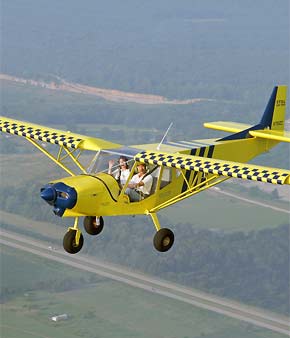Regular readers will know that my flying club requires an annual flight review in addition to the FAA-mandated biannual one, and for this year’s review I decided to combine it with a refresher in a complex plane. I haven’t flown a complex plane in quite some time and while I’m not real sure I have much desire to do so in the future, it’s good to do something different.
And so there we were in N6291R, a Cessna 172 RG, at KMYF early last evening. Given the rapid onset of nighttime we decided to the landings first and then we’d go out for the maneuvers. First things first, give Ground a call:
[audio:http://www.leftturnwhenable.us/wp-content/uploads/2010/09/BFR-2010-Ground.mp3]
On the way out to taxiway Juliet we had to pull off into a parking area to let a lifeguard flight in, only to find that the parking area was exactly where the lifeguard wanted to go so we had to do some creative taxiing to get out of it’s way. That done, we did the run up and got our closed traffic clearance.
My CFI requested a soft-field take off which I pretty much failed at so when we came back in for a soft-field landing I pretty much failed at that too. I think the Tower could see me sigh, let alone hear me. Second soft-field take off was much better, then a normal landing just to let me get used to the 172RG which went well, then a short-field take off. Totally nailed a short-field landing and then we were off out to the coast.
The practice area was quite busy, 3 or 4 other planes out doing the maneuvers so we found a spot and went through the usual items: slow flight with the stall warning on, stalls (first one is always bad for me), steep turns (love doing those), emergency landings, simulated instrument work such as unusual attitudes and compass turns. Whilst under the hood, my CFI had me tune in the OCN VOR and track a course to it. The VOR indicated a course of about 270 which was what I expected, but the DI showed it to be a right turn whilst I was pretty sure it was going to be a left turn since I thought I had been heading north. But, “trust your instruments” so I took the turn and followed the radial which kept changing as I progressed…. the winds have come up giving me a crosswind? I’m sure you’ve already worked out where this is going and perhaps if the plane’s DME was working I would have spotted it but eventually my CFI revealed to me that he had turned the DI 180 degrees so I was indeed heading away from the VOR, this being a lesson to cross check ALL instruments while IFR. Bit of a cheesy trick for a flight review, really, but point taken.
Everything done, we headed south along the coast where we could see a lot of lightning over Mexico but it seemed too far south to be any worry to us. The Tower confirmed they had been watching it and was no factor. We were assigned left traffic for 28L but the left isn’t lighted so we asked for 28R. Turns out the controller misspoke, she meant to give us 28R, it took a while for me to find the airport (I kept seeing Miramar) but once located I got the plane slowed up (I love how throwing down the gear puts the brakes on), made our entry and made a firm landing on 28R. Taxi back to parking and the flight portion was done.
In order to complete the review we retired to a nearby Starbucks and spent some time reviewing the FARs and going over some “what ifs” that are local to the San Diego area. Always good to review the local problem areas and procedures.
So, 1.5 hrs more complex flight time in the book and another year’s flying privileges in the club.

 The 750 is a Light Sport Plane and therefore doesn’t require a valid FAA medical to fly it. Sport pilots aren’t allowed to fly at night or in IFR but as an IFR-rated Private pilot I would be allowed to fly it in those conditions if the manufacturer’s operating conditions allow it. I’ve no idea if they do right now, though they do have an IFR-certifiable kit plane in the 650 so maybe it’s not beyond the realm of possibility. I’m not sure if I’d want to fly IFR in this type of plane (too light, too slow), but night flight would definitely be desirable.
The 750 is a Light Sport Plane and therefore doesn’t require a valid FAA medical to fly it. Sport pilots aren’t allowed to fly at night or in IFR but as an IFR-rated Private pilot I would be allowed to fly it in those conditions if the manufacturer’s operating conditions allow it. I’ve no idea if they do right now, though they do have an IFR-certifiable kit plane in the 650 so maybe it’s not beyond the realm of possibility. I’m not sure if I’d want to fly IFR in this type of plane (too light, too slow), but night flight would definitely be desirable.